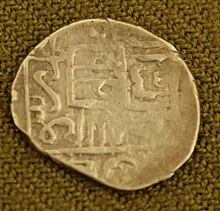Farrukh Yasar (Persian: فرخ یسار) was the last independent Shirvanshah of Shirvan (1465–1500). In 1500, the first Safavid ruler, Ismail I, decisively defeated and killed Farrukh Yasar during his conquest of the area. Descendants of Farrukh Yasar continued to rule Shirvan under Safavid suzerainty, until 1538, when Ismail's son and successor Tahmasp I (r. 1524-1576) appointed its first Safavid governor, and made it a fully functioning Safavid province.[1]
| Farrukh Yasar I فرخ یسار | |||||
|---|---|---|---|---|---|
| Shah of Shirvan | |||||
 Silver coin minted during reign of Farrukh Yasar | |||||
| Reign | 1465–1500 | ||||
| Coronation | 1465 | ||||
| Predecessor | Khalilullah I | ||||
| Successor | Bahram | ||||
| Born | 1441 Baku | ||||
| Died | 1500 Baku | ||||
| Spouse | Daughter of Usmi of Kaitag Adil Beg | ||||
| Issue | Gazi Beg Shirvanshah Bahram Beg Ibrahim II Sheykhshah Gawhar-Sultan Khanum | ||||
| |||||
| House | House of Shirvanshah | ||||
| Father | Khalilullah I | ||||
| Religion | Islam | ||||
Relations
editAq Qoyunlu
editHe averted strategy of his ancestor's - alliance with Timurids, instead he moved towards Uzun Hasan. He married his daughter to Uzun Hasan's son Yaqub. On 31 January 1468 the combined forces of Shirvanshahs and the Aq Qoyunlu defeated Timurid khan Abu Sa'id Mirza. Future sultans of the Aq Qoyunlu – Baysunghur and Murad – were his grandsons.
Ottomans
editHe sent his "Khalaf al-Umara and Akabir" (Deputy of emirs and nobles) Ziyaaddin Yusif and his personal merchant Khawja Yar Ahmad with 2 bullions of gold to Istanbul, in order to establish relations with Mehmed the Conqueror.
Russia
editIn 1465, Shirvanshah envoy Hasan Shirvani was sent to Moscow in order to establish diplomatic relations, in response Ivan III of Russia sent an embassy with leadership of Vasily Papin and a group of merchants (which also included Afanasy Nikitin) for trade and a pact against Golden Horde.[2]
Safavids
editDuring Uzun Hasan's reign, relations with Safavids were quite peaceful. But in 1488 Shaykh Haydar of the Safaviyya Shia sect moved through Shirvan towards Derbent, supposedly to wage jihad against the Circassians, but instead laid siege to Shamakhi. He captured the capital and burned it. Farrukh Yasar was not able to mount a defense and asked his son-in-law Sultan Yaqub of Ak Koyunlu to come to his rescue on 9 June 1488. Upon hearing his arrival, Sheikh retreated to Derbent. The combined forces of the Aq Qoyunlu under Suleiman Bey and the Shirvanshah forces which were led by shah himself, attacked to Qizilbash on 9 July 1488. Their combined forces were able to defeat the Safavid Qizilbash forces and Shaykh Haydar was wounded by an arrow. He was captured by gatekeeper Ali aga who severed his head and sent to Sultan Yaqub.
Aq Qoyunlu civil war
editUpon death of his son-in-law in 1490, he supported his grandson Baysunghur for keeping the throne. In 1492, he fled to Shirvan upon dethronement. However he was killed in a battle between Barda and Ganja. The brother of Baysunghur, Murad also fled to Shirvan sometime later and stayed there until 1497.[3]
Sheikhshah
editIn 1497 Shaki ruler Shah Husain rebelled with Shah's youngest son future king Ibrahim II Shaykhshah and raided Gabala for 8 days. Shah crushed them with his other sons and Abulfath beg - the Vali of Gabala. However, they were pardoned.
Later reign and death
editYoung Ismail was freed by his cousin, the new Aq Qoyunlu sultan Rustam in 1492. He decided to take revenge of his father, but rulers of Ardabil, Ali beg Jayirli and Talysh ruler Muhammad, who were vassals of the Shirvanshahs, did not give any help when demanded. Ismail then moved on to Qarabagh and then to Erzincan. In 1499, he began to march on Shirvan. Two forces met on Battle of Jabani, near Shamakhi. Shirvan's forces were devastated and shah were captured and beheaded.[4] Ismail captured Shamakhi, and moved on to Baku.
Legacy
editHe was remembered as merciful and glorious ruler by many sources.[5] Construction of Tuba Shahi Mosque and Juma Mosque in Derbent were patronized by himself.[6]
Family
editFarrukh Yasar was married to daughter of Usmi of Kaitag Adil bey
- Gazi Beg - Shirvanshah in 1501.
- Shirvanshah Bahram Beg - Shirvanshah in 1502.
- Ibrahim II Sheykhshah - Shirvanshah after his brothers.
- Gawhar-Sultan Khanum – Married to Uzun Hasan son Yaqub.
References
edit- ^ Fisher et al. 1986, pp. 212, 245.
- ^ M.M.Алтьман. Из истории торгово-дипломатических cвязeй Mocквы и Шиpвaнa. Tp. Ин-тa истории им. A.Бaкиxaнoвa, т.I, Бaкy, 1947, c.157
- ^ The early yeaгs of Shah Isma'il, founder of the Safawi Dynasty, by E. Denisson Ross. JRAS, vol. 29, 1896. p.257-260
- ^ Hasan Rumlu - Ihsan at Tawarikh
- ^ "Tarikh-i alam ara-yi Amini" by Fazlallah bin Ruzbihan, p. 67-71
- ^ T.M.Myceви. Cpeднeвeкoвыe дoкyмeнты пo истории b Бaкy, 1967, c.81-82
Sources
edit- Fisher, William Bayne; Avery, P.; Hambly, G. R. G; Melville, C. (1986). The Cambridge History of Iran. Vol. 6. Cambridge: Cambridge University Press. ISBN 978-0521200943.
- Minorsky, Vladimir (1958). A History of Sharvān and Darband in the 10th-11th Centuries. Cambridge: W. Heffer & Sons, Ltd.